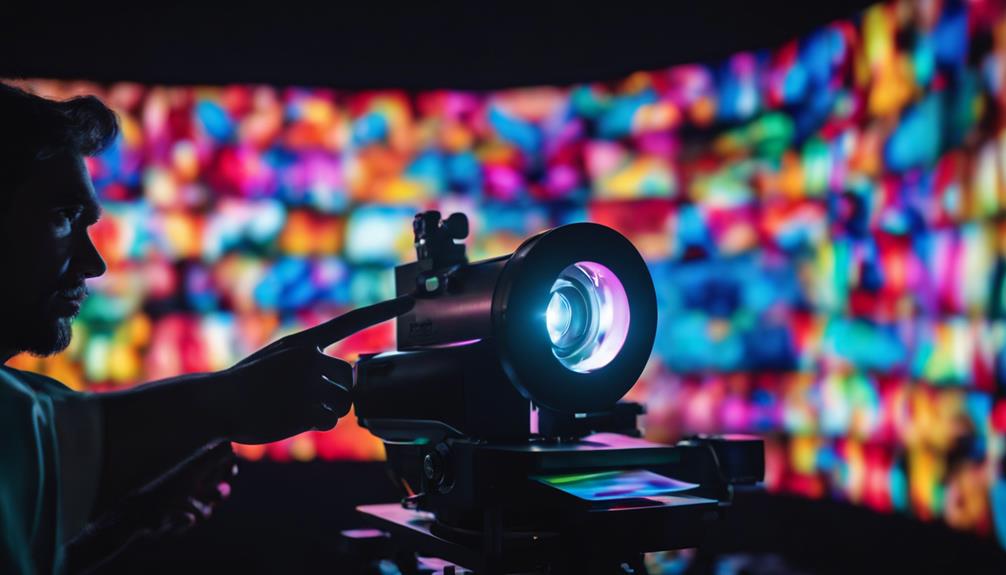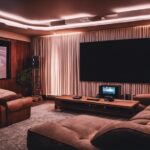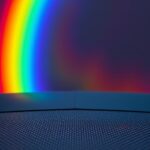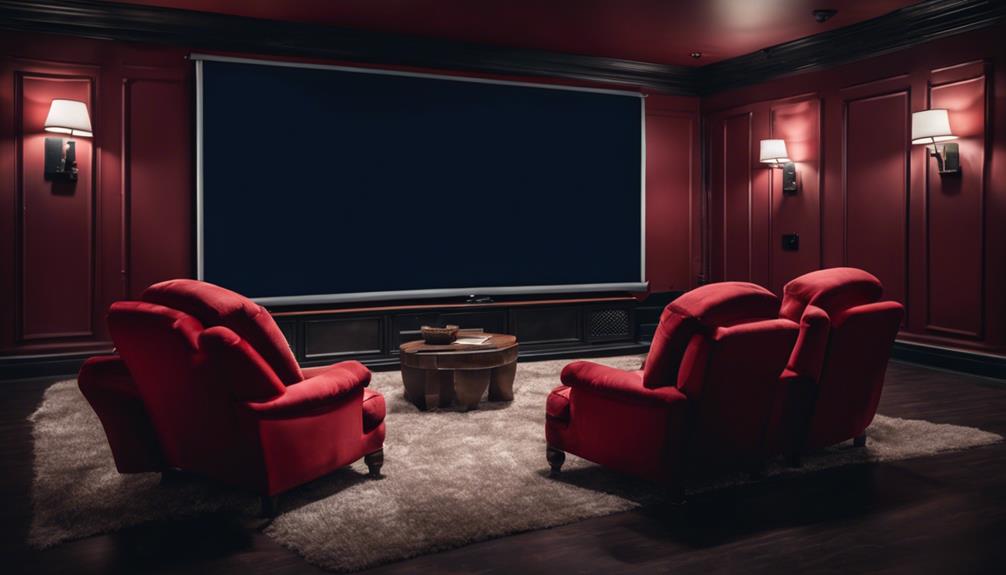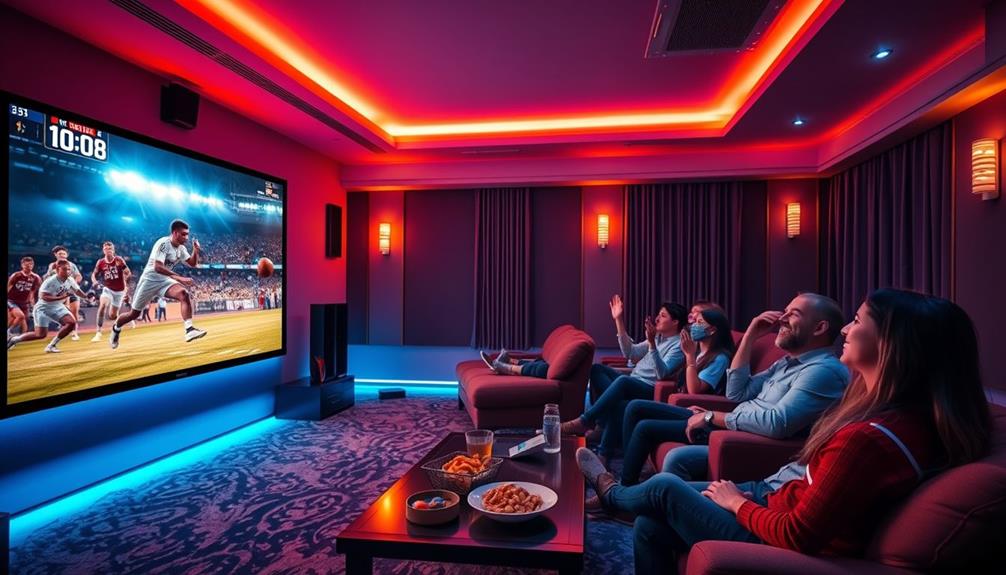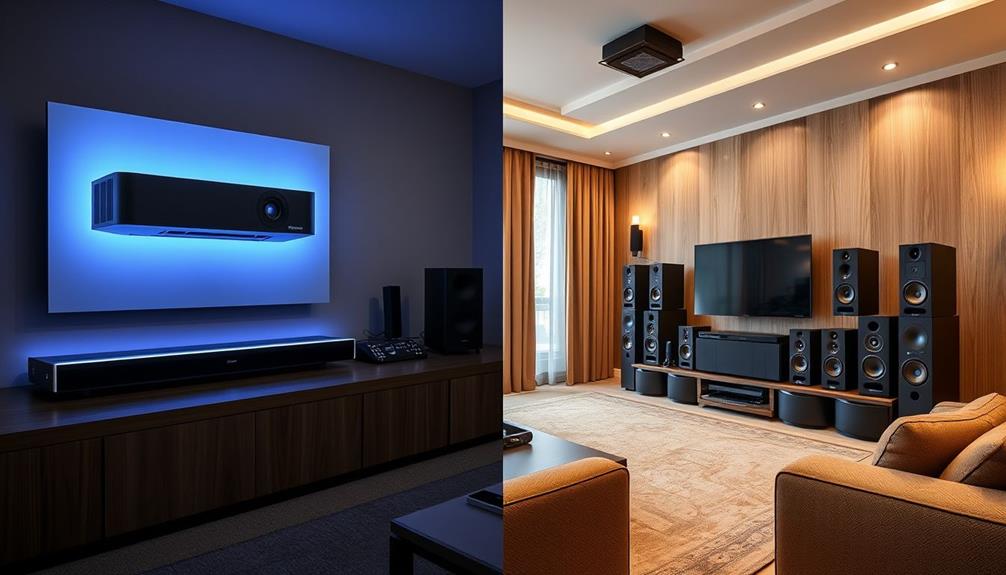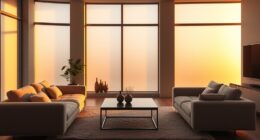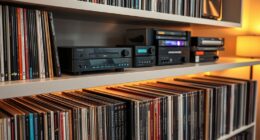When troubleshooting color issues in your projector displays, start by checking the lamp's condition, as aging bulbs can distort colors. Clean dusty lenses and filters to prevent image degradation. Inspect the color wheel and verify all cables are securely connected without damage. Adjust settings for brightness and contrast based on manufacturer guidelines. If you notice color shifts, verify the environment for excessive heat or sunlight. Regular maintenance, including calibrating your projector, can greatly enhance your viewing experience. Keep exploring for additional tips and techniques that can help you achieve ideal color performance.
Key Takeaways
- Regularly clean projector lenses and filters to prevent dust buildup that can distort colors.
- Adjust color settings and calibrate the projector to enhance color accuracy and vibrancy.
- Check and replace aging projector bulbs to maintain consistent color output.
- Ensure proper ventilation and monitor for overheating to prevent color shifts and inaccuracies.
Common Causes of Color Issues
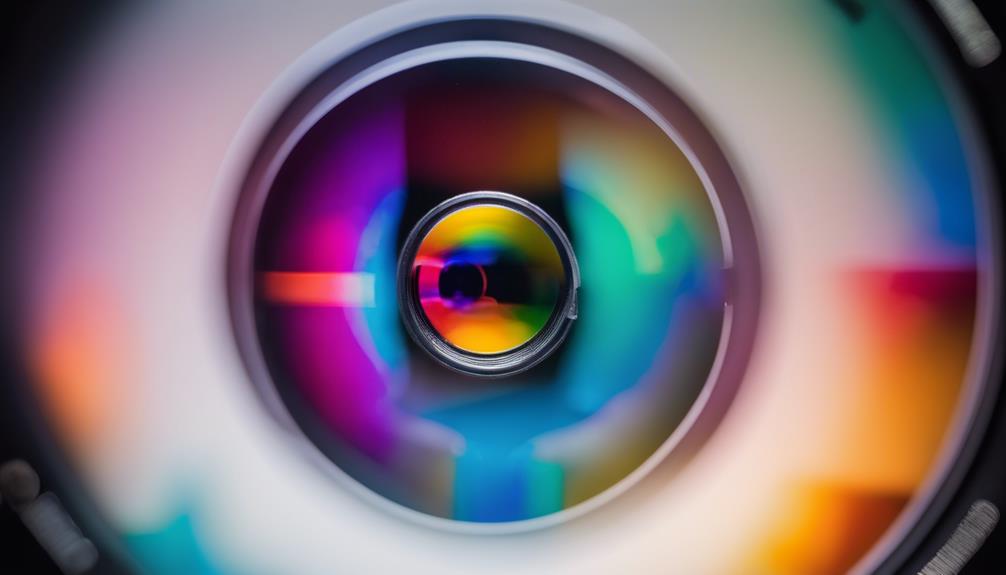
Color issues in projectors often arise from a few common culprits that can disrupt your viewing experience. One major factor is the aging projector lamp. As the lamp ages, it can degrade color output, leading to color distortion and washed-out images. If you notice colors appearing muted or imbalanced, replacing the lamp might be necessary.
Another common issue is the color wheel, especially in DLP projectors. If the color wheel malfunctions, you could experience considerable color inaccuracies, such as a complete wash of specific colors like red or blue, resulting in an unsatisfactory picture. Checking the color wheel for any signs of wear or damage can be essential in resolving these problems.
Lastly, environmental factors, such as dust accumulation or excessive heat, can impact projector performance. Dust can block light paths, leading to color distortion, while heat can cause components to malfunction. Guarantee to keep your projector clean and properly ventilated to assure peak performance.
Identifying Prism Problems
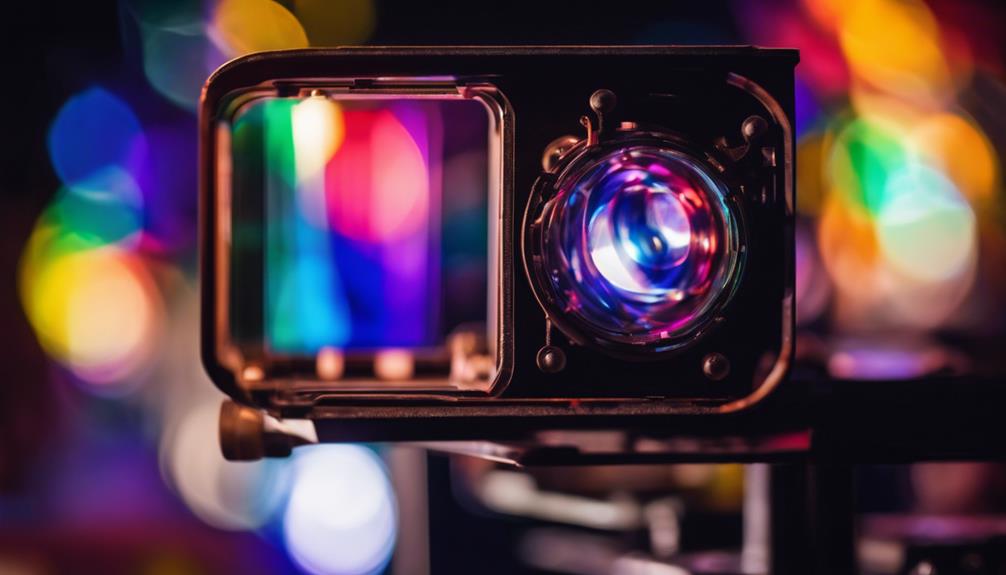
Identifying prism problems in your projector can greatly enhance your viewing experience by pinpointing the source of color inaccuracies.
Prisms are essential components that filter specific colors of light emitted from the lamp. If you notice a color problem, such as washed-out colors or inconsistent hues, the prism might be the culprit. Over time, these prisms can heat up and change their properties, leading to decreased color accuracy in your projected images.
Start by inspecting the front glass prism for any signs of damage or discoloration. This simple check can reveal issues that noticeably affect the overall color accuracy of your projection.
If you suspect problems but can't see any visible damage, it might be time to seek professional evaluation. They can diagnose any underlying prism-related issues that aren't immediately apparent.
Solutions for Color Issues

To resolve color issues in your projector, start by inspecting and cleaning the color wheel for any damage or misalignment. A damaged or misaligned color wheel can lead to significant inaccuracies in color, especially in DLP projectors.
Next, check all video cables, including your VGA cable, confirming they're secure and undamaged. Loose or frayed cables can disrupt the color signals, resulting in poor image quality.
Adjust the projector's color settings through its menu to calibrate for ideal balance and saturation, following the manufacturer's guidelines. It's crucial to confirm that the settings reflect the content you're displaying.
If color problems persist, consider replacing aging projector bulbs, as they can degrade over time and cause inconsistent color output.
Projector Brands and Support
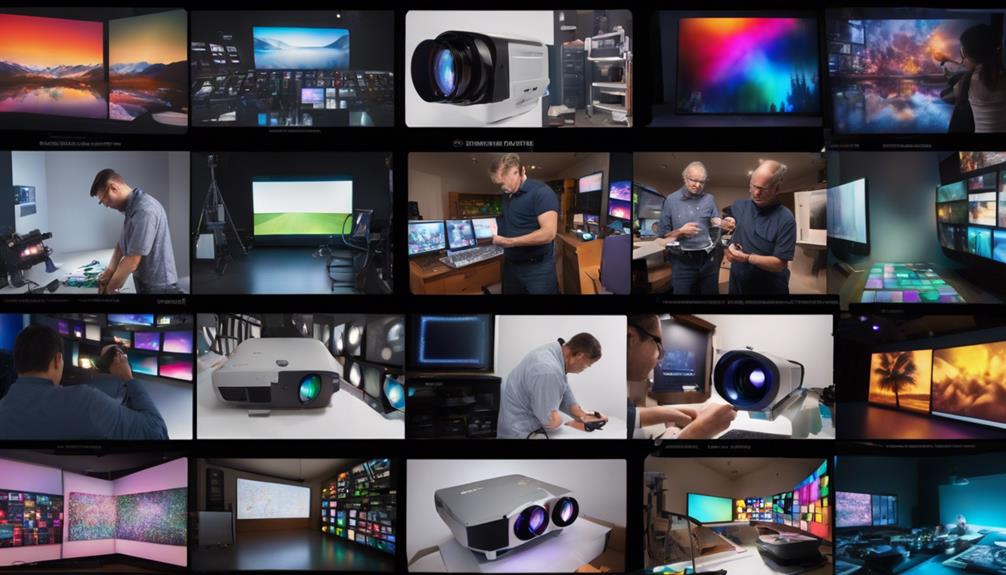
When choosing a projector, it's essential to contemplate brand-specific support options, as they can greatly influence your troubleshooting experience and overall satisfaction.
Different projector brands, like BenQ and Optoma, have unique designs that may affect color accuracy. For instance, these brands use front prisms in their lamp modules, which can malfunction and lead to color distortion or inconsistency in projected images.
Manufacturer support is important when you encounter color issues. By contacting the brand's support team, you can identify the root cause of the problem, potentially saving time and money on unnecessary repairs. They can help you pinpoint which specific component needs attention, ensuring you get back to enjoying vibrant displays quickly.
Moreover, staying informed about brand-specific updates and recalls is critical. These updates can enhance your awareness of potential color-related issues, allowing you to address them proactively.
Resources like MyProjectorLamps offer valuable support for troubleshooting color problems across various projector brands, guiding you through repairs and associated costs.
Ultimately, knowing your projector brand's support options empowers you to maintain ideal color accuracy in your displays.
General Maintenance Tips
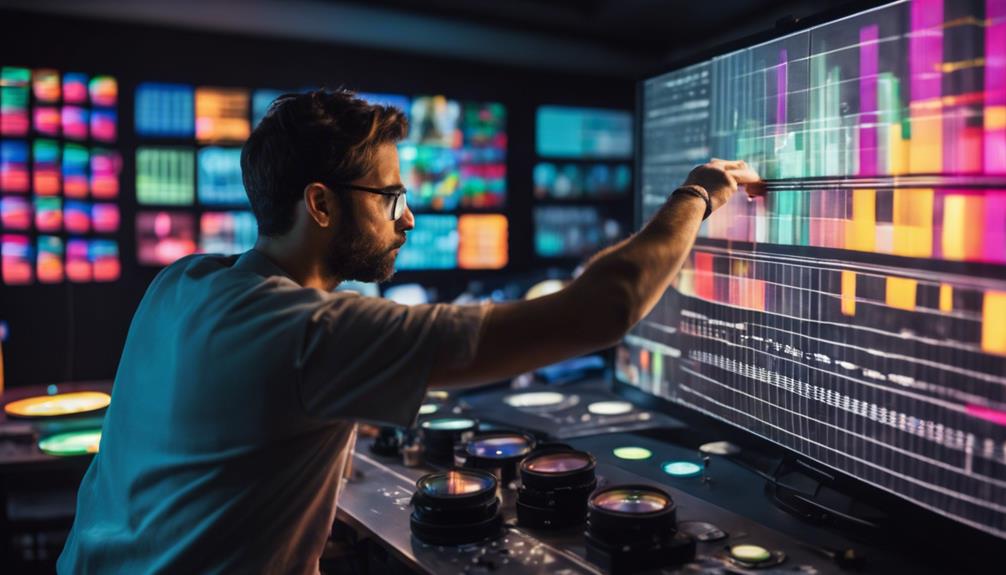
Maintaining your projector with regular upkeep can greatly enhance its performance and color accuracy, making it less likely for you to encounter display issues.
Start by regularly cleaning the air filters and vents to prevent dust buildup, which can lead to overheating and color distortion. A simple wipe with a soft cloth can keep the projector lenses clear, helping you achieve ideal image clarity and preventing discoloration caused by dirt.
Keep an eye on your lamp usage hours; replacing bulbs according to the manufacturer's guidelines guarantees consistent color output and brightness.
Additionally, consider where you store your projector. Keeping it in a dust-free environment and avoiding excessive heat will help extend its lifespan and maintain color accuracy.
Lastly, don't overlook the importance of professional maintenance. Scheduling periodic check-ups can help identify and address potential issues early, guaranteeing your projector operates at peak performance.
Common Projector Issues
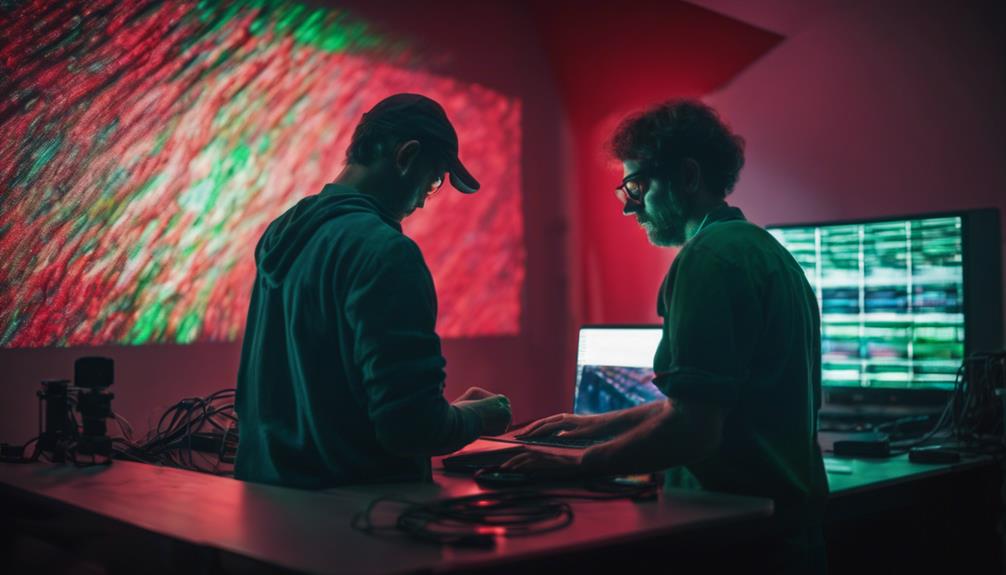
When you're dealing with common projector issues, image brightness and clarity are often at the forefront.
You might notice washed-out colors or darkness that requires adjusting the brightness or contrast settings.
Additionally, if the image appears blurry or misaligned, tweaking the focus and alignment can make a significant difference in your viewing experience.
Image Brightness Adjustments
How can you effectively adjust the brightness of your projector's image to enhance clarity and reduce any washed-out appearance? Start by checking your projector's brightness settings. If the image seems too light, increasing the contrast can restore balance and improve image quality. Conversely, if dark images appear, you might be facing bulb failure. Here, increasing the brightness temporarily helps until you can replace the lamp.
Here's a quick guide to help you with brightness adjustments:
| Issue | Adjustment Needed | Notes |
|---|---|---|
| Image too washed out | Increase contrast | Helps restore image balance |
| Image too dark | Increase brightness | Temporary fix for bulb issues |
| Blurry image | Adjust focus dial | Sharpens clarity |
| Misaligned image | Make foot adjustments | Properly align with the screen |
Focus and Alignment Issues
Focus and alignment issues can greatly affect your viewing experience, often requiring simple adjustments to restore image clarity and positioning.
If your image appears blurry, start by using the focus dial on the lens to sharpen it. This quick adjustment can make a significant difference in clarity.
If the projected image seems misaligned, check if the top and bottom are parallel. You might need to make foot adjustments or perform keystone corrections to fix this issue. A well-aligned image enhances your overall experience.
Dust accumulation on the lens can also lead to blurry images. To clean it, gently use a soft cloth, ensuring you don't scratch the lens. This little maintenance task can help restore clarity effectively.
If you notice that your image looks too light or washed out, try adjusting the contrast settings. This can improve overall image quality and make colors more vibrant.
Conversely, dark images might signal a potential bulb failure. Start by increasing the brightness and check the condition of the bulb to see if it needs replacement.
Addressing these focus and alignment issues will greatly enhance your projector experience.
Troubleshooting Techniques

To tackle color issues in projector displays, start by testing different cables and checking all connections for security and damage. Loose or damaged cables can lead to poor signal transmission, which can affect color accuracy. Additionally, using high-quality cables, such as those with gold-plated connectors, can enhance conductivity and reduce interference.
Here are some key troubleshooting techniques to follow:
- Test the projector with a different VGA or HDMI cable to identify potential faults related to signal transmission.
- Reset the projector's color settings to default; this often resolves minor issues stemming from incorrect configurations.
- Verify the functionality of any video splitters used, as faulty units can distort colors and impact overall image quality.
Environmental Factors to Consider
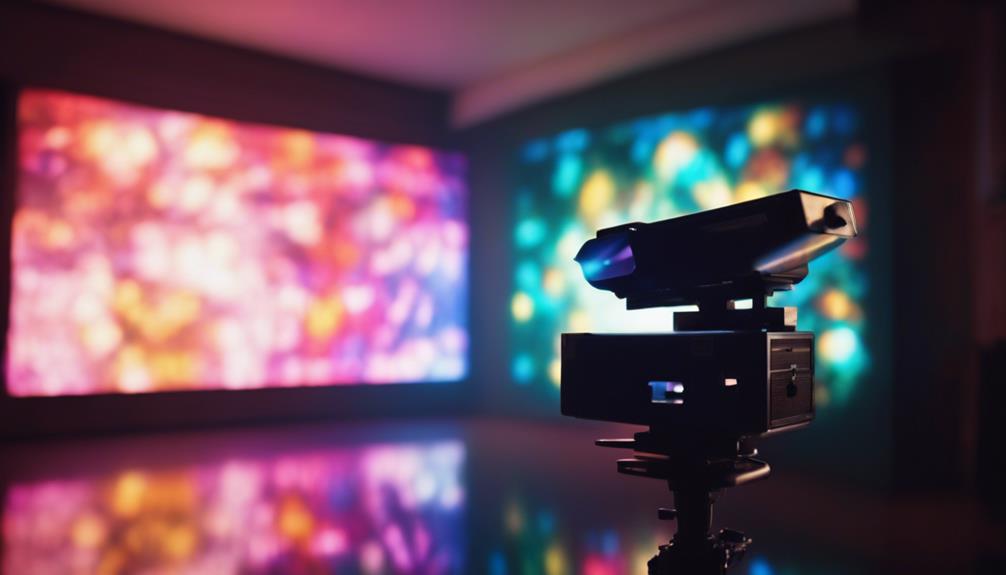
When you're setting up your projector, don't overlook the impact of environmental factors on color quality.
Ambient light can wash out the colors, while temperature and humidity can lead to serious performance issues.
Keeping your projector clean and in the right conditions will help you achieve the vibrant display you want.
Ambient Light Influence
Ambient light greatly impacts how vibrant and accurate projected images appear, often washing out colors and diminishing contrast in less controlled environments.
If you want to achieve the best results with your projector, consider the following factors related to ambient light:
- Direct Sunlight: Avoid projecting in areas with direct sunlight, as it can cause colors to appear faded or altered.
- Color Temperature: Be aware that the type of lighting—warm incandescent versus cool fluorescent—can change how colors are perceived on your screen.
- Lighting Control: Maintaining a consistent and controlled lighting environment is essential. Aim for minimal external light sources during presentations.
Temperature and Humidity
Controlling temperature and humidity in your projector's environment is just as important as managing ambient light for achieving accurate color displays.
High temperatures can lead to overheating, causing color distortions and negatively impacting performance. Ideally, you should keep your projector in a space where temperatures range between 60°F and 80°F (15°C to 27°C). This range helps maintain consistent color output.
Humidity levels also play a significant role. When humidity exceeds 60%, moisture can accumulate inside the projector, potentially damaging internal components and further altering color accuracy.
Fluctuations in temperature can lead to thermal expansion and contraction of the projector's components, contributing to color misrepresentation over time.
To enhance color fidelity and prolong your projector's lifespan, maintain a controlled environment. Guarantee proper ventilation and humidity control to prevent these issues.
By taking these steps, you'll be setting your projector up for the best possible performance, allowing you to enjoy accurate and vibrant displays without the hassle of color inconsistencies.
Dust Accumulation Effects
Dust accumulation on your projector's lenses can drastically diminish image clarity and brightness, leading to noticeable color distortions in your displays. Over time, dust can obstruct the light path, resulting in uneven colors and potential overheating issues that further compromise color accuracy. To maintain peak performance, regular cleaning is vital.
Here are a few key points to reflect on:
- Clean Optical Surfaces: Regularly wipe down the lenses and mirrors to prevent dust buildup.
- Check Air Filters: Clean or replace air filters frequently to guarantee proper airflow and cooling.
- Control the Environment: Keep your projector in a low-dust area, avoiding places with high humidity where dust can settle more easily.
Maintaining a clean operating environment is essential; even minor dust accumulation can have cumulative effects on image quality and color fidelity over time. By taking these steps, you can enhance your projector's performance and enjoy vibrant, accurate colors in your displays.
Preventative Maintenance Strategies
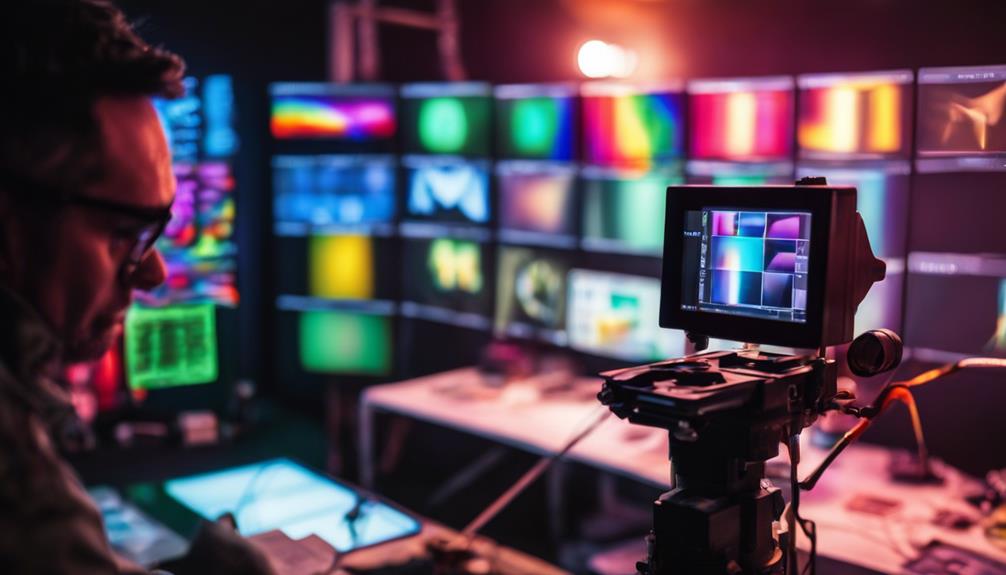
To guarantee vibrant colors and ideal performance in your projector, make regular preventative maintenance a top priority.
Start by cleaning air filters and vents frequently to prevent dust buildup. Dust can lead to overheating, which often distorts colors in your displays.
Next, invest in high-quality, shielded cables for stable signal transmission. This reduces the risk of color inaccuracies due to interference.
Also, be mindful of where you store your projector; keep it in a controlled environment, away from direct sunlight and extreme temperatures. This helps maintain peak performance and color reproduction.
Monitor your lamp usage hours closely. Follow the manufacturer's guidelines for timely replacements, as aging lamps can skew color balance considerably.
User Experiences and Solutions
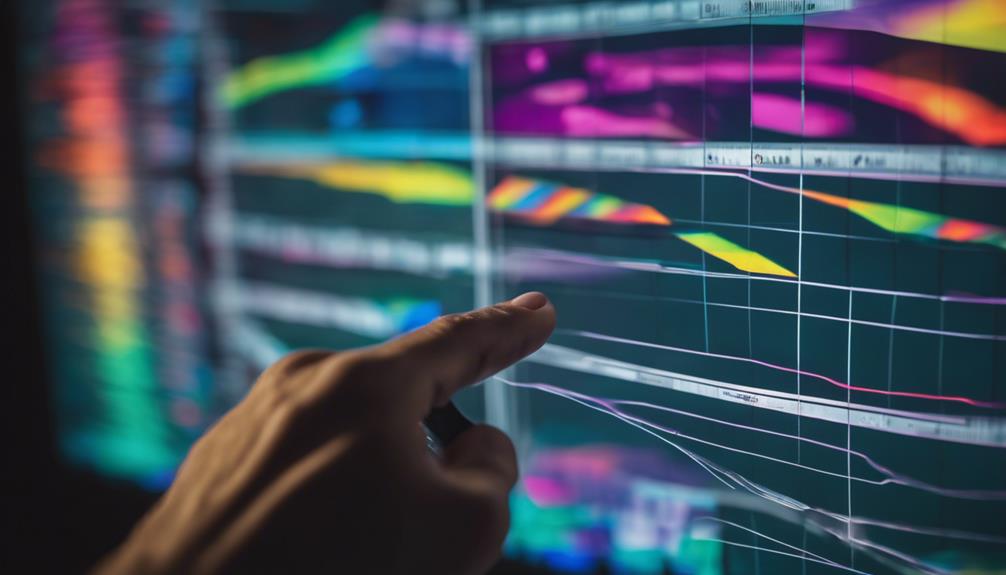
When you face color problems with your projector, it's crucial to identify the common issues that could be at play.
Quick fixes like resetting your devices or adjusting GPU settings can often make a perceptible difference.
Additionally, consider how environmental factors might be affecting your display, as they can greatly impact color accuracy.
Common Color Problems
Have you ever encountered a washed-out image with a strong red or blue hue while using your projector? This issue often points to problems with the projector's color wheel or potential lamp degradation, which may require replacement. You might also notice color inaccuracies due to faulty connections.
Here are some common issues to take into account:
- Cable Connections: Check for disconnections or damaged VGA cables, as they can lead to distorted colors. Testing with alternative cables often helps isolate the problem.
- Color Settings: Adjust your projector's color settings to match the manufacturer's recommended configurations. This can resolve minor distortions you experience during presentations.
- Ambient Light: Excessive ambient light in the room can wash out projected colors. Controlling the lighting is vital for achieving clearer images.
Quick Fix Techniques
Many users find that quickly resetting their projector to factory settings can effectively resolve frustrating color issues. This step restores the default color profiles, often eliminating any distortions you might be experiencing.
If resetting doesn't work, try testing with a different video source, like a laptop or another HDMI device. This helps you isolate whether the problem is with your projector or the original device.
Next, check all cable connections. Many users report success in resolving color distortions simply by securing loose or damaged cables.
If your connections are solid, explore the projector's menu and adjust the color settings. Fine-tuning RGB levels can greatly enhance your color output.
Lastly, consider upgrading to high-quality, shielded cables. Users who've made this switch often notice a marked improvement in color fidelity as it reduces interference.
Environmental Impact Factors
Controlling ambient light and maintaining a clean, well-ventilated environment can dramatically enhance your projector's color accuracy and overall performance. To achieve the best results, consider these environmental impact factors:
- Room Lighting: Limit ambient light interference by using blackout curtains or dimming the lights during presentations. This will help you achieve ideal viewing conditions.
- Regular Cleaning: Dust accumulation can lead to overheating and diminished color fidelity. Make it a habit to clean your projector regularly for consistent performance.
- Proper Ventilation: Confirm your projector has adequate airflow. Excessive heat can cause temporary color shifts, so position it in a well-ventilated area.
Frequently Asked Questions
Why Is My Projector Showing Weird Colors?
Your projector's showing weird colors due to potential issues like faulty components, incorrect settings, or environmental factors. Check connections, clean the lens, and adjust settings to see if it improves the color quality.
Why Is My Projector Displaying the Colors on the Screen Incorrectly?
Your projector might display colors incorrectly due to misconfigured settings, damaged cables, or environmental factors. Check for loose connections, adjust color settings, and consider replacing the lamp if it's aging or failing.
What Is the Most Likely Reason for This Problem Projector Is Displaying the Colors on the Screen Incorrectly?
Imagine you're watching a movie, but the colors look like a washed-out painting. The most likely reason your projector's displaying colors incorrectly is a misconfigured setting, which you can easily adjust in the projector menu.
How Do You Calibrate a Color Projector?
To calibrate a color projector, access the menu, adjust RGB levels, and use a color calibration tool for precise measurements. Set it to a test pattern to visually fine-tune color reproduction for ideal results.
Conclusion
In summary, tackling color issues in your projector doesn't have to be intimidating.
By understanding common causes and applying the troubleshooting techniques we've discussed, you can restore vibrant displays.
Remember, regular maintenance and awareness of environmental factors play an essential role.
Don't let color problems ruin your viewing experience—stay proactive!
If you visualize these steps as a checklist, you'll find it easier to manage and resolve any issues that arise, keeping your projector in top shape.
